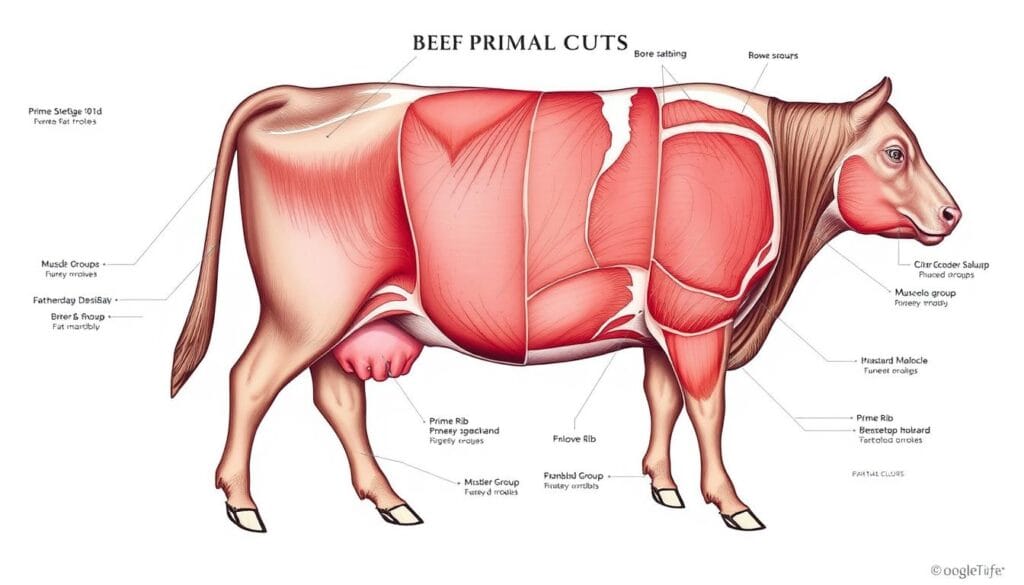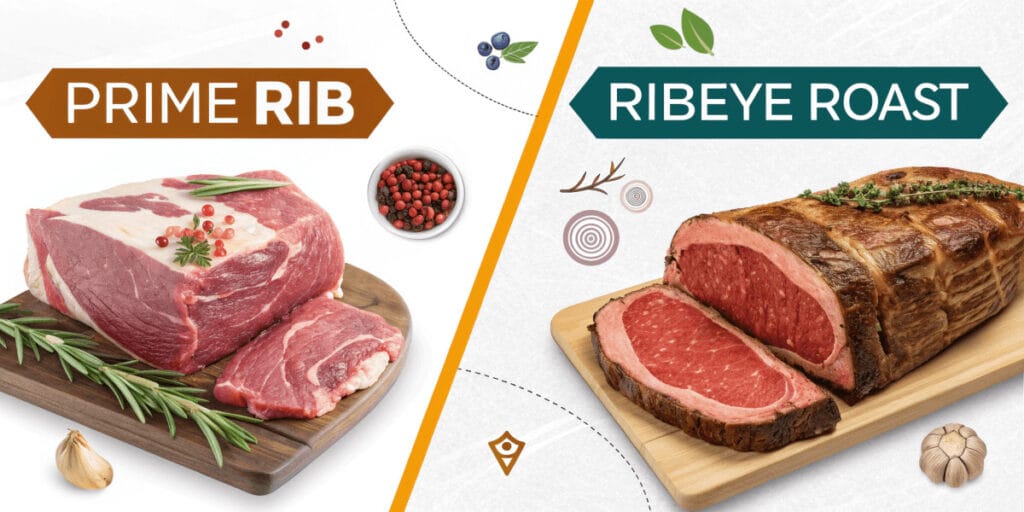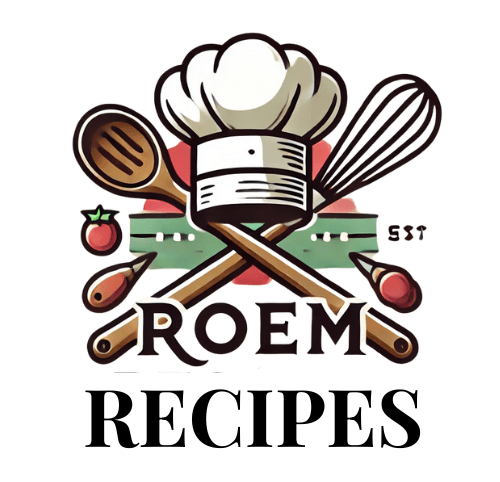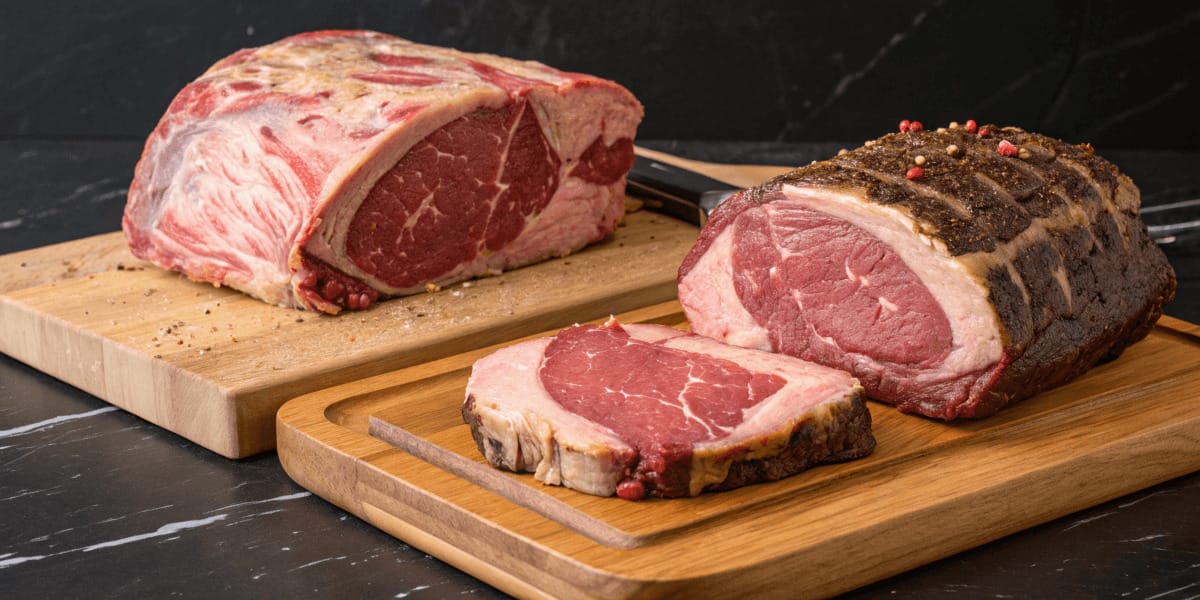Ever stood at the butcher counter, unsure about the beef cuts? Wondered about the differences between prime rib and ribeye? You’re not alone. These two cuts from the rib section offer unique dining experiences.
The world of beef cuts is complex, especially when comparing prime rib and ribeye. Both come from the rib section, known for its tender and marbled meat. American butchers carefully choose these cuts, knowing they’re among the best.
Exploring rib roast vs. prime rib reveals differences in preparation and serving. Ribeye roast vs. prime rib might seem similar, but each needs a special approach. This unlocks maximum flavor and tenderness.
This guide will help you understand these amazing beef cuts. You’ll learn what to choose for your next special meal. Get ready to impress your friends and family with your new knowledge.
Understanding the Basic Cuts: Origins and Anatomy
When we talk about prime rib vs ribeye roast, knowing the basics of beef cuts is key. The cow’s body is split into primal sections. The rib primal cut is especially important in our cooking adventures.

The rib primal section is in the cow’s front part. It’s famous for tender and tasty cuts. This area has little muscle movement, making the meat top-notch.
The Rib Primal Section Breakdown
Prime rib and ribeye roast both come from this top section. This cut is known for:
- Minimal muscle movement
- Exceptional tenderness
- Rich marbling
- Concentrated flavor profile
Sub-Primal Cuts Explained
Inside the rib primal section, there are many sub-primal cuts. The prime rib is a bigger roast. The ribeye is a smaller, more compact cut.
| Cut Type | Size | Typical Preparation |
|---|---|---|
| Prime Rib | Larger Roast | Whole Roasting |
| Ribeye | Smaller Steak | Grilling/Pan Searing |
Bone Structure and Placement
A big difference between ribeye roast and prime rib is their bone structure. Prime rib has the bone, which adds flavor. Ribeye, on the other hand, is usually boneless.
“The bone isn’t just a structure, it’s a flavor conductor.” – Professional Butcher
Knowing these details helps you choose the right cut for your cooking. It’s all about what you like and how you cook.
Prime Rib vs Ribeye Roast: Main Differences

Exploring prime rib vs ribeye reveals key differences. These differences make each cut unique. Size, preparation, and serving methods can change your dining experience.
Prime rib is a large, impressive cut with multiple ribs. It’s great for big gatherings or special events. On the other hand, ribeye is a smaller, individual steak. It’s perfect for personal servings.
“The art of choosing between prime rib and ribeye is about understanding their distinct characteristics.”
- Prime rib: Larger cut, slow-roasted whole
- Ribeye: Smaller individual steak, quickly grilled or pan-seared
- Cooking method dramatically impacts flavor and texture
Is prime rib better than choice ribeye? It depends on what you like. Prime rib is tender from slow roasting. Ribeye has a unique char and firmer texture. Your choice depends on:
- Number of people being served
- Desired cooking technique
- Personal flavor preferences
Prime rib cuts can weigh up to 16 pounds. This makes them much larger than ribeye steaks. Size affects cooking time and serving options.
Pro tip: Select a USDA Prime grade for the best quality, regardless of which cut you choose.
Marbling and Fat Content Comparison
When we talk about prime rib vs ribeye roast, knowing about fat is key. The way beef is marbled affects its taste, softness, and how it feels in your mouth.
Types of Fat Distribution
Fat spreads out differently in prime rib and ribeye roast. Prime rib has more marbling because of its bigger muscles. This fat makes the meat:
- Richer in flavor
- More tender
- Moist and juicy
Impact on Flavor and Tenderness
The taste and feel of your meal change with fat content. Prime rib gives a luxurious, melt-in-your-mouth feel. This is different from ribeye’s leaner taste.
The secret to exceptional beef lies in its marbling – the delicate white streaks of fat throughout the meat.
USDA Grading Considerations
| Beef Grade | Marbling Level | Prime Rib Characteristics | Ribeye Characteristics |
|---|---|---|---|
| Prime | Abundant | Maximum flavor, most tender | Exceptional marbling |
| Choice | Moderate | Good quality, less fat | Balanced fat content |
| Select | Minimal | Leaner, less flavorful | Limited marbling |
Knowing these details helps you pick the right cut for your dish. Whether it’s a rib roast or prime rib vs ribeye, you’ll make a great choice.
Size and Portion Considerations
When you’re deciding between prime rib and ribeye, knowing the portion sizes is key. The size difference affects how you cook and serve the meat.
A full prime rib roast can be up to 20 pounds. This makes it great for big gatherings or special events. On the other hand, ribeye steaks are usually 8 to 12 ounces each. They’re perfect for individual servings.
“Choosing between prime rib and ribeye depends on your crowd size and culinary ambitions.”
Portion Recommendations
- Prime Rib: 1/2 to 3/4 pound per person
- Ribeye Roast: 1/3 to 1/2 pound per serving
- Teenage boys or larger appetites: Consider increasing portions
Serving Size Comparison
| Cut Type | Average Weight | Typical Servings |
|---|---|---|
| Prime Rib Roast | 15-20 pounds | 20-25 people |
| Ribeye Steak | 8-12 ounces | 1 person |
When picking between rib roast and prime rib, think about your meal. Big family dinners or holiday meals are perfect for prime rib. For smaller, more intimate dinners, ribeye steaks are the way to go.
Your choice should match the number of guests, cooking time, and the meal’s size. Each cut has its own benefits in size and presentation.
Cooking Methods and Techniques
When you compare ribeye roast and prime rib, knowing the right cooking methods is key. Each cut needs special preparation to bring out the best flavor and tenderness.
Prime Rib Roasting Fundamentals
Prime rib does best with slow, gentle roasting. Here’s how to do it right:
- Cook at low temperatures (around 250°F)
- Let it cook for several hours for even heat
- Use a meat thermometer for exact doneness
For the best results, aim for these internal temperatures:
| Doneness Level | Internal Temperature |
|---|---|
| Rare | 120°F |
| Medium-Rare | 130°F |
| Medium | 140°F |
Ribeye Roast Preparation Techniques
Ribeye roast is more flexible in cooking. You can:
- Grill at high temperatures (450-500°F)
- Pan-sear for a crispy outside
- Oven-roast for even results
Temperature and Timing Tips
When deciding between ribeye roast and prime rib, keep these tips in mind:
- Always let the meat rest after cooking
- Use a reliable meat thermometer
- Avoid overcooking to keep it tender
“The key to exceptional beef is understanding its unique characteristics and respecting its natural qualities during preparation.”
Whether you pick prime rib or ribeye roast, mastering these cooking techniques will boost your cooking skills. It will also wow your dinner guests.
Flavor Profiles and Texture Differences
Exploring prime rib vs ribeye roast reveals interesting differences. Prime rib offers a luxurious, tender experience. It’s almost melt-in-your-mouth soft.
The flavor profiles of these cuts are unique:
- Prime rib has a uniform, deep beef flavor
- Ribeye has a more intense beef taste
- Fat distribution affects flavor
Is prime rib better than choice ribeye? It depends on what you like. Prime rib’s fat makes it buttery and succulent. Its fat cap melts during slow roasting, adding deep flavor.
| Characteristic | Prime Rib | Ribeye Roast |
|---|---|---|
| Flavor Intensity | Rich, Uniform | Concentrated, Robust |
| Texture | Extremely Tender | Firm, Juicy |
| Fat Content | Higher (23g per 100g) | Moderate (15g per 100g) |
“The magic of these cuts lies not just in their flavor, but in the culinary experience they create.” – Beef Culinary Expert
Cooking methods greatly affect flavor. Prime rib gets a uniform roasted taste from slow cooking. Ribeye, when grilled or seared, gets a charred exterior. Both offer a great dining experience for meat lovers.
Cost Comparison and Value Analysis
Understanding the prices of prime rib and ribeye roast helps you make better choices. The cost of these premium beef cuts changes based on several important factors. These factors affect their market value.
Market Pricing Factors
Why is ribeye roast so expensive? The price reflects many things, not just the meat’s quality. Key factors include:
- Marbling intensity
- USDA grade classification
- Specific cut location
- Regional supply and demand
Seasonal Price Variations
Prime rib vs ribeye prices change a lot throughout the year. Prices go up during holidays like Christmas and Thanksgiving. This is because more people want to buy them then.
Best Value Considerations
When looking at beef cut value, think about more than just the price per pound. The best choice for you depends on what you need.
| Cut Type | Average Price/lb | Serving Potential | Best Used For |
|---|---|---|---|
| Prime Rib | $17.99 | 6-8 people | Large gatherings |
| Ribeye Roast | $14.50 | 4-6 people | Small dinner parties |
Remember, tender cuts from the rib or loin primal are pricier. They have better marbling and texture. Walmart offers good prices on choice grade cuts like the Beef Choice Ribeye Steak. Customers love its taste and grilling quality.
“The quality of beef is determined not just by price, but by understanding the unique characteristics of each cut.”
Serving Suggestions and Pairings
Choosing the right sides and wine can make your meal special. Whether you pick prime rib or ribeye roast, the right sides and wine can turn a simple meal into a memorable one.
Classic Side Dish Selections
Here’s what people like to serve with rib roast and prime rib:
- 30% of side dishes feature vegetable-based options
- 9 potato-based side dish recipes show their favorite
- Vegetable variety includes asparagus, broccoli, green beans, and Brussels sprouts
Vegetable and Potato Pairings
These side dishes go great with your prime rib or ribeye roast:
- Creamy mashed potatoes with herb butter
- Roasted Brussels sprouts with bacon
- Cheesy vegetable gratins
- Garlic-roasted parsnips
“The right side dish can transform a good meal into an unforgettable dining experience.” – Culinary Expert
Wine and Beverage Pairings
Finding the perfect wine is key when comparing prime rib and ribeye roast. Here are some wine pairing suggestions:
| Meat Cut | Wine Recommendation | Flavor Profile |
|---|---|---|
| Prime Rib | Cabernet Sauvignon | Bold, full-bodied |
| Ribeye Roast | Malbec | Medium to full-bodied |
Let your roast rest before serving for the best taste and juiciness. Pro tip: Serve with a classic horseradish sauce for an extra flavor kick!
Before deciding between prime rib and ribeye roast for your next meal, you might want to explore different cooking techniques that enhance their flavors. For instance, using the sous vide method for prime rib can result in an evenly cooked, tender roast that’s bursting with flavor. Learn more about this technique in our detailed guide here: Sous Vide Prime Rib Roast. And if you’re looking for additional recipes and tips to elevate your culinary game, don’t forget to check out our full collection of mouthwatering dishes on Roem Recipes.
Conclusion
Choosing between prime rib and ribeye comes down to a few key things. Ribeye roast has 217 calories per 100g, making it leaner. Prime rib, on the other hand, has 290 calories, offering a richer taste. Your cooking skills, the event, and what you like will help you decide.
Deciding between ribeye roast and prime rib isn’t easy. Prime rib is great for big gatherings, needing 3-5 hours to prepare. It’s cooked slowly for a special touch. Ribeye is better for quick, hot cooking and is perfect for one or two people.
Think about your kitchen, how you like your meat, and how many you’re serving. Prime rib is perfect for big groups, making a great centerpiece. For small dinners, ribeye roast is ideal. Always plan for half a pound per person and focus on seasoning and cooking techniques.
Whether you pick prime rib or ribeye, getting the temperature right and letting it rest is key. With the right attention and knowledge, you can make any meal special.

